On Romanes
Romanes, often also denoted as Romani Čhib or Romani Šib [the Roma language], is originally spoken by all Roma and continues to be so by many Roma in the world. Be it either by migration or by work and social niche specialization, Roma divided themselves into distinct groups. Some groups, such as many of the Hungarian Carpathian Roma or the Spanish Cale, have completely lost the language, partly due to earlier bans on speaking Romanes. Others only speak it in a version that is heavily mixed with the national language, in which not much of the original language has been preserved.
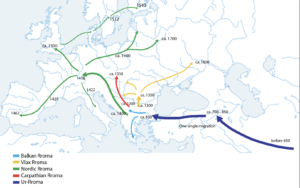
The Indian origins of Romanes was first discovered by the end of the 18th century by the Hungarian aristocrat István Valyi, also Váli or Wáli, (1729/30–1779). From the middle of the 19th century, well-known studies were published, such as those by August Friedrich Pott (1802–1887), Alfred Graffunder (1801–1875) and Franz von Miklosich (1813–1891), followed by studies by English linguists such as John Sampson (1862–1931). The origin of the language is Prakrit, which is the spoken form of Sanskrit. Romanes still has a strongly articulated Indian morphology, as well as a large proportion of words from the Indian vocabulary.
Romanes has a multi-layered structure that has its origin in the early migrations of the Proto-Roma from India. Some layers, such as the Indian roots, are extremely strong, while others, such as the Armenian, are slightly less important, judging by the number of words the Armenians have contributed with to the language. Words from Prakrit, Old Persian, Armenian, Greek and South Slavic are common for all Roma dialects and these provide the homogeneous foundation on which all the dialects are built. Note that there are no traces of Semitic languages in Romanes, neither Arabic nor Syriac. We can only find borrowings that come from Turkish among the Balkan Roma groups, and those must be newer.
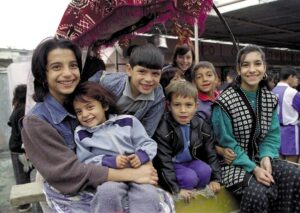
Roma who speak Romanes are at least bilingual. They speak the local language and Romanes. Ottoman Turkish is often added in the Balkan states, and in some places, such as Kosovo, it is not unusual for Roma to speak four languages (often Romanes, Albanian, Turkish and Serbian). This universal multilingualism is one of the reasons for the existence of these loanwords. If you immigrate to another region, the old national language is also brought with you. Since it is usually not understood in the new place, words from the previous country are integrated into Romanes.
Common Trunk and Dialect Groups
Common Trunk
The Common trunk covers all linguistic influence in Romanes common to all Roma and their respective dialects. It starts with Prakrit and its grammar, with many words referring to village life. The very shallow level of acquisitions in pre-Islamic Persia contains words that pertain to travels such as vurdon [carriage], but also kež [silk], kuštik [belt], taxtaj [glas], and many more. From Persia, Roma passed and stayed for a while in Greater Armenia, a region that encompasses the eastern part of modern-day Turkey up to the Mediterranean coast. This influence brought the horse (grast or graj) but also other items such as momeli [candle], thagar [king], xanamik [co-father in law], and some metals such as arčič [tin].
Momeli is particularly relevant, as it is in the old Armenian phonetic form, with an l which evolved into gh in Armenian. This sound change allows us to set dates around the presence of the ancestors of the Roma there. There are also a few lexemes of Georgian and Kurdish origin, but these are fewer in number.
The stay in the Byzantine Empire left a broad Greek linguistic influence in Romanes. The number of Greek words is large and covers much work terminology such as amoni [anvil], xarkuma [copper], petalo [horseshoe], foro [town, market], them [land, country] and also numbers such as efta, oxto, enja [7,8,9], trianda [thirty]; and so on.
The added Greek words, together with the much shallower borrowings of Southern Slavic origins, mark the boundary of the common vocabulary between various Roma dialects but also, interestingly, these words are kept as the last layer of Romane lava [Romanes words]. Subsequent acquisitions are usually treated as foreign words and have differing declensions.
Meta-dialects and Dialects
Roma continued to migrate from Southeastern Europe, mainly because of the advance of the Ottomans in the Balkans. This gave rise to four large dialect groups:
- The Vlach Roma, who lived in the Romanian-speaking area. They absorbed a lot of Romanian (sometimes also Hungarian) lexemes and even parts of the grammar into their dialects.
- The Carpathian Roma, who settled mainly in modern-day Hungary, Slovakia, the Czech Republic, and Austria. They show a strong influence of Hungarian.
- Balkan Roma are those who remained in the region under Ottoman rule, thereby showing a strong influence of Turkish in their dialect.
- Finally, we should mention the group that immigrated to German-speaking countries at the beginning of the 15th century. From this point, Roma went to Italy, Spain, France, Britain, and Scandinavia. Because of persecution in Germany, some fled eastwards to Poland, the Baltic States, Ukraine, and Russia. Their dialects show German influences – some more, others less.

One can thus group the various Romanes dialects into four broad categories which we call “meta-dialects”, corresponding to the first level of new acquisitions above the common trunk. The figure represents this first layer of acquisitions: For Nordic dialects, one finds a first (sometimes shallow) layer of German; for Carpathian, a first layer of Hungarian; for the Vlach, of course, the ubiquitous Romanian; and finally, for the Balkan dialects, Turkish influences. Note that these distinctions – with a geographical connotation – do not represent the nowadays geographical spread of these dialects. After all, the “archetypal” Vlach dialect of the Kalderaša is nowadays spoken all over the world as a result of recent migrations of these Roma.
Understanding Each Other
It is often claimed that different dialects of Romanes are incomprehensible to one another. The background is simple: A Polish Romanes speaker, for example, does not understand Romanian. So when he speaks to Vlach Roma he doesn’t understand the Romanian loanwords.
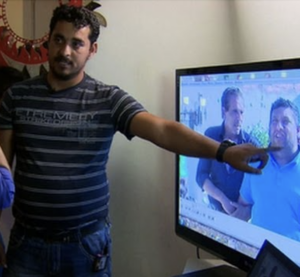
However, Romanes is constructed in such a way that the original Romani words have been preserved alongside the borrowings. If you know the language well, you can easily overcome this hurdle. It should be noted that the dialects of the Vlach Roma are the most distant from the others, and therefore the least understandable for the others. It is more difficult with modern words and concepts. Terms such as ‘television’, ‘telephone’, ‘airplane’, etc. are borrowed exclusively from the local language and are therefore often incomprehensible to other Roma if they have not borrowed the same term.
Common Trunk and Vocabulary
If one restricts oneself to the common trunk and the first level of acquisitions above it, and one excludes local acquisitions, Romanes does not have a large number of words. Typically, this encompasses around 3,000 words, with about double as many meanings. If one adds the contextual uses, somewhat more. In comparison to the vocabulary of other European languages such as English, German, and French, these have a vocabulary that is two orders of magnitude larger. An educated English speaker will on average have an active vocabulary of around 20,000 words with a passive vocabulary twice as large or more than that. Normal day-to-day communication uses far less than that number. Fluency in English requires around 3,000 words, which brings us back to levels observed in Romanes.
Acquisitions
Romanes would not continue to be spoken without local acquisitions/loans. At the time, where most Roma meta-groups separated (around 700 years ago), many items of everyday life simply did not exist. There were no televisions, computers, telephones, cars, but also windows, apartments, etc. may have been rare.
So what happens in Romanes: One usually loans a word from the local (or the previous local) language. It is usually put in a Greek form by adding the masculine singular -o ending to the word. Hence, fernsevo or televisiono for a television [German Fernseh], vonungo [German Wohnung] for a flat, and so on.
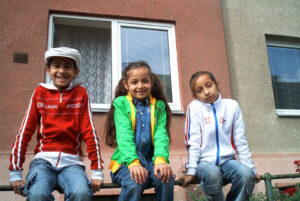
Sometimes, these acquisitions coexist with the original Romanes vocabulary. In the case of vonungo [a flat], this term is used in Vienna, Austria, by Roma from the Balkans to denote where they live in the city. When they use the word kher [a house], they refer to their homes in their country of origin.
Romanes is often choosey in which acquisitions it takes into its vocabulary. A typical case is the word for ‘window’. Sinti use the word voknin whereas their eastern neighbours, the Polska Roma, will use fenstra. Voknin is of Slavic origin, coming from okno [window] in most Slavic languages, [1] while fenstra comes from the German Fenster [Window]. Why the difference? Simply because the Slavic word is not understood in German-speaking lands, and nor is the German one in Slavic countries.
Periphrases and Context
Forgetting about the more recent acquisitions and vocabulary, Romanes is extremely inventive in its use of periphrases to extend the vocabulary. In fact, it is so inventive that in most Romanes conversations, the knowledge of single words will not result in any understanding of the conversation. Take some elementary examples based on the verb dav [to give]. In the Baltics, Poland, Belarus, Ukraine, and Russia dav kan [literally ‘I give ear’] means ‘to call someone on the phone’. Among Vlach Roma dav anglal [lit. ‘I give forward’] means ‘to answer’. The list of the various uses of the verb ‘to give’ is almost endless.
Another such verb is lav [to take]. The pendant of dav anglal is lav angla [‘I take forward’] meaning ‘to go around’ among Vlach Roma. Lav sama [I take to myself] means ‘to look’ or ‘to notice’. The meanings of words are also often extended. One such example is bašav [to bark, to make noise]. It is normally only used for animals, but again contextually. Džukel bašel [the dog barks] but so will a bašno [rooster]. However, if you say in Romanes So bašes čhibasa? [lit. ‘why do you bark (or ‘make noise’) with your tongue?’] this effectively means ‘why do you chat?’.
Sometimes, old Romanes words or periphrases based on the common trunk vocabulary are used in Romanes to denote newer utensils or things. When you say čhiv da mas de šilali [put the meat in the refrigerator] in Russian Romanes, you use šilali as the feminine nominalized adjective of šilal-o -i [cold]. One can also hear that someone travelled with the satruno drom [steel road] meaning ‘by train’ or with a sastruno čiriklo [a steel bird], ‘a plane’.
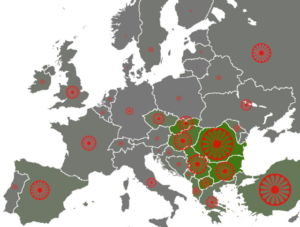
Sometimes, it is almost impossible even to guess why an expression took a meaning. Among Vlach Roma mak means ‘a fly’. But Kalderaša and Lovara will say leski mak sas kadja [‘his fly was like this’] meaning ‘So was his destiny’. It gets even more complicated. One also hears vov mardja leski mak [he beat his fly] meaning ‘he won’. Even more confusingly, to say naj les mak [he has no fly] means ‘he is a failure’. Another such example is the use of burjaca [mushrooms] by Kalderaša. Clearly, it is used in this sense, but one can also say vov nakhlja opral paj burjaca [lit. ‘he passed above and through mushrooms’] meaning ‘he has a great experience’. But if you say divano burjacengo [lit. ‘the mushroom talk’] it simply means ‘dumb talk’. Agor means ‘edge’ among Vlach Roma. How could one guess that when someone says našti dav po (ando) agor [lit. ‘it is not possible to give to the edge’] it means ‘I cannot understand it’? Or when one says khonik našti del leske ando agor [lit. ‘no one can give it to him on the edge’] it means ‘no one can convince him’?
Some of those periphrases refer to paramisja [Roma tales]. Saying that someone was telal o podo [under the bridge] in some places in the Balkans this means ‘that person is dumb’. This refers to a paramisja where one day God was distributing intelligence, and some people were sheltering under a bridge, and they missed out. There are numerous instances like these and expressions that refer to traditional stories which require the knowledge of the tales and culture to understand it.

In some cases, the names given to items in Romanes are derived from slang, from misunderstandings of the meaning in the local language, or from bilingual creativity and humor. In France, the Manouches sometimes use šop nakerskro [six nosed] for ‘a cinema’, often shortened in French to ciné which sounds like French six nez [six noses]. Sinti in Germany sometimes call Nuremberg Bukengero Foro [the city of kidneys] as in some southern German dialects Nuremberg is deformed to Nierenberg – from the German Niere [kidney]. In Russia, the district administration is called baluni [hairy] because its Russian name was Volostnoje Upravlenije (волостное Управление), close enough to volosnoje (волосное) [hairy] in Russian.
In some cases, Roma uses words to avoid being understood. If you say “give me a hundred francs/roubles/pounds”, you are obliged to use the name of the currency in the local language, something that is easily recognisable. If you say de man šel marde [lit. 100 beaten ones], meaning ‘100 units’, the external understanding gets more complicated. In Russia, where (besides the ruble) the dollar was an alternative currency, de man šel marde would mean ‘100 roubles’, whereas de man šel na amare [give me 100 not ours] would refer to ‘100 dollars’.
Oaths are a serious matter among Roma. Oaths and curses are never far apart since oaths are nearly always accompanied by a curse, as it can be seen in the Kalderaša phrase dav ma armaja me či kerdem kodja [may I be cursed but I didn’t do it]. Among Vlach Roma, the use of te merav te na čačipe / čačimos phenav [may I die if I don’t tell the truth] is common. It makes the use of te merav me aratji [may I die yesterday] all the funnier.
Understanding and Using Romanes
These examples highlight the difficulties for non-Roma to fully grasp the richness of Romanes. The language and its use are closely connected to the oral history, the tradition, and also to a wealth of images and paramisja that are fairly common to most groups. It means that one can express many more thoughts, nuances, and feelings than what would be expected by just the mere word count.
It also means that a good Romanes speaker can say things in a way that is totally unintelligible to someone who only knows the meaning of each of the words, as that person would not have the reference and context required for a full understanding. But it also means that for the language to survive in a full and complete expressive form, it is not sufficient to know the words, but one needs to keep one’s traditions and culture. Without these, Romanes would lose a large part of it richness and colour, and would surely decline.
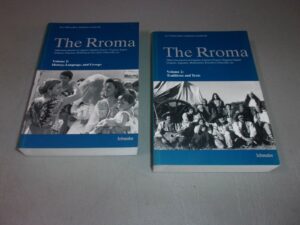
Stéphane Laederich is the director of the Zurich based Rroma Foundation. Together with Lev Tcherenkov, he co-authored the book “The Rroma” (2005), as well as more recently a grammar and vocabulary of the Polska, Litovska, Lotfitka, and Xaladytka Roma (University of Graz).
[1] with the typical prothetic “v” used by Roma in the region.









2 thoughts on “International Romani Day”